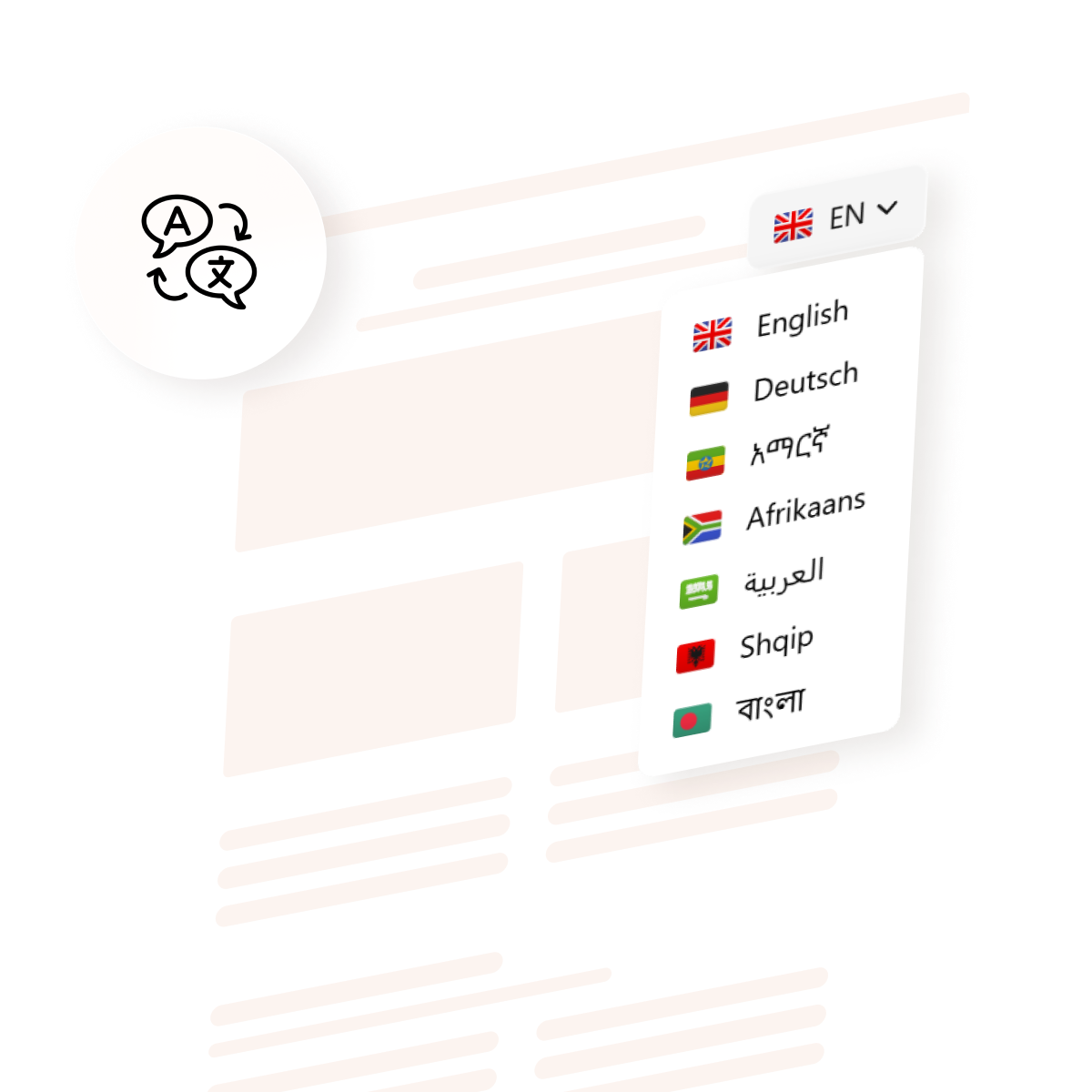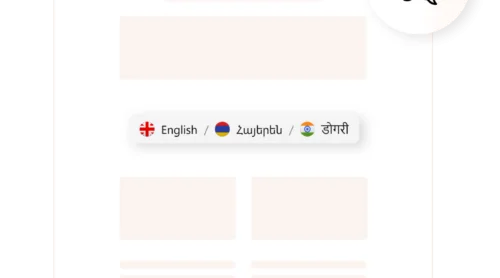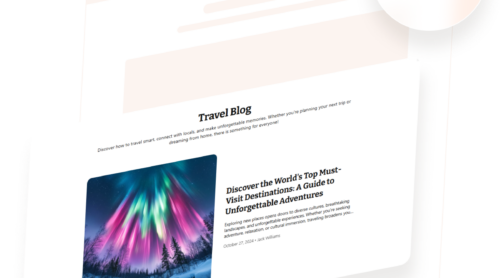What is a Multilingual Website?
A multilingual website is a platform designed to present content in multiple languages, allowing users from different linguistic and cultural backgrounds to navigate and interact with the site seamlessly. It features language options, often through a language switcher, enabling users to select their preferred language easily.
Unlike simple translation, a multilingual website involves careful localization to ensure cultural relevance, accuracy, and consistency. This includes adapting not only the text but also visuals, formatting, and other design elements to meet the expectations of diverse audiences.
Website Translation vs. Website Localization: Key Differences
When businesses aim to expand their online presence to international audiences, both multilingual website translation and website localization play crucial roles. While these terms are often used interchangeably, they serve distinct purposes in creating a global-friendly website.
- Multilingual website translation
This process focuses on converting the text of a website into multiple languages, ensuring the original meaning remains intact. It involves translating content such as:- Page titles and meta descriptions
- Blog articles
- Product descriptions
- Contact forms or FAQ sections
Translation prioritizes accuracy and clarity, preserving the core message without altering its cultural context. Businesses that rely on multilingual site translation services often target audiences who speak different languages but share similar cultural nuances.
- Website localization
Localization goes beyond translation by adapting content to resonate with the cultural, social, and legal expectations of specific regions. This process involves:- Adjusting imagery, icons, and colors to suit cultural preferences
- Formatting dates, currencies, and measurement units according to local standards
- Adapting slang, humor, and idiomatic expressions for cultural relevance
For example, a localized multilingual ecommerce website not only translates product descriptions but also adjusts prices to reflect the local currency and integrates payment options familiar to the region, such as PayPal, WeChat Pay, or others.
- Purpose. Translation focuses on language, while localization emphasizes cultural adaptation.
- Scope. Multilingual translation converts text, whereas localization may include design, user interface, and even marketing strategies.
- Audience engagement. Localization often delivers a deeper emotional connection with users by tailoring the experience to their cultural identity.
Both approaches are critical for businesses venturing into global markets. While multilingual translation ensures accessibility for diverse language speakers, website localization offers a personalized and culturally relevant experience, increasing engagement and trust.
For companies translating websites or adapting their platforms to international audiences, a strategic combination of both processes is often the best approach.
Benefits of a Multilingual Website
Reaching a global audience
Creating a multilingual website allows businesses to expand into international markets by offering content in multiple languages. This strategy not only attracts a broader user base but also opens opportunities to engage with niche regional audiences.
Enhancing user experience
Users are more likely to stay on and interact with a website when the content is presented in their native language. By implementing multilingual website services, businesses can improve user comprehension, boost engagement, and drive higher conversion rates. A seamless, language-friendly experience ensures better customer satisfaction, which is key to building loyalty.
Boosting SEO with multilingual strategies
A multilingual website SEO strategy enhances a web page’s visibility in local search engines. Techniques such as translating and localizing keywords, using hreflang tags for search engine indexing, and creating region-specific URLs are essential for driving organic traffic. With optimized multilingual website content, businesses can rank higher in international search results and gain more exposure.
Strengthening brand credibility
Offering a localized and multilingual website demonstrates a company’s commitment to inclusivity and respect for diverse cultures. This builds trust among users and showcases a brand’s global presence. Businesses using multilingual website translation and localization services are more likely to foster long-term relationships with their international customers.
Gaining a competitive edge in the global market
Nowadays, businesses that invest in multilingual website development gain a significant competitive advantage. Tailored content in multiple languages allows companies to outperform competitors with single-language platforms by reaching previously untapped global markets.
By implementing website translation strategy and website localization best practices, businesses can maximize their global reach and establish a strong online presence across diverse regions.
Best Practices for Multilingual Websites
Implementing multilingual website best practices is essential for creating a smooth, impactful, and globally accessible user experience.
- Develop a structured multilingual website translation strategy
A well-planned multilingual website translation approach ensures consistency across languages. Use glossaries, style guides, and content management systems to standardize terminology, tone, and formatting for all language versions. - Focus on website localization best practices
Go beyond simple translation and embrace website localization best practices to adapt content, visuals, and functionalities for cultural relevance. For example, display local currencies, customize time formats, and adjust imagery or color schemes to resonate with the target audience. - Leverage professional translation services
Partner with professional multilingual website services to ensure high-quality translations that reflect cultural nuances. Unlike machine translation, expert services deliver accurate and tailored content, particularly for technical or industry-specific materials. - Optimize multilingual website SEO
Improving SEO for multilingual websites is key to increasing international visibility. Incorporate these strategies:- Use hreflang tags to indicate language-specific pages.
- Create region-specific URLs (e.g., /es for Spanish content).
- Avoid duplicate content penalties by implementing canonical tags.
- Translate and localize keywords for better local search engine rankings.
- Ensure accessible and intuitive design
An effective multilingual website design makes navigation seamless for users. Key considerations include:- Prominently placing a user-friendly language switcher.
- Adjusting layouts to accommodate varying text lengths across languages.
- Using culturally relevant imagery and symbols to enhance user engagement.
- Integrate multilingual website services and tools
Streamline your multilingual strategy by leveraging tools like Elfsight’s widgets for translation and localization. For instance, integrate Website Translator widget to ensure smooth management of your multilingual website content.
- Continuously test and optimize your multilingual website
Regularly conduct quality assurance checks to identify translation errors, cultural inaccuracies, or design inconsistencies. Gather user feedback to refine the multilingual website experience and maintain optimal functionality across all language versions.
By adopting these localization and website translation best practices, businesses can offer a globally relevant, user-friendly experience that boosts engagement, enhances credibility, and supports international growth.
Examples of Multilingual Websites
Looking at multilingual website examples can inspire businesses aiming to expand their global reach through effective multilingual web development strategies.
- ASOS
This global retailer sets a benchmark in how to make a multilingual website. ASOS offers region-specific versions with localized languages, currencies, and personalized product recommendations, ensuring a seamless user experience.

- Airbnb
Airbnb exemplifies how to make a multilingual website user-friendly. With a prominent language switcher and fully localized content, the platform ensures users worldwide can navigate with ease and confidence.

- IKEA
IKEA’s multilingual eCommerce website integrates local currencies, payment options, and shipping policies tailored to specific markets. This is one of the finest multilingual website examples, combining functional design with cultural adaptability.

Common Mistakes in Multilingual Websites
Avoiding pitfalls in multilingual web development is key to ensuring a smooth and effective global presence. Here are some common mistakes to steer clear of:
- Overreliance on machine translation
Machine translation tools may offer convenience, but they lack the accuracy and cultural nuance needed for a high-quality multilingual website. Always review and localize content to reflect cultural and linguistic specifics. - Ignoring multilingual SEO best practices
Failing to implement hreflang tags, localized metadata, or region-specific URLs compromises your multilingual website SEO. These omissions can severely affect search rankings and visibility in local markets. - Neglecting cultural sensitivity
Overlooking cultural differences in imagery, tone, or design can alienate users and diminish your brand’s impact. Effective multilingual website development accounts for these nuances to foster inclusivity. - Inconsistent branding across languages
A lack of cohesive translation and localization strategy may lead to inconsistencies in branding. To avoid this, establish guidelines for tone, style, and terminology across all language versions of your multilingual website. - Skipping technical optimization
Slow-loading pages or incompatible features can frustrate international users. Ensure your website prioritizes technical performance, such as optimizing for varying internet speeds and mobile responsiveness in different regions.
By learning from successful examples and avoiding these common mistakes, businesses can create impactful, globally accessible platforms that resonate with diverse audiences.
Conclusion
Building a multilingual website goes beyond simple translation – it’s about delivering a user experience tailored to diverse audiences. By following best practices like multilingual website development, localization, and SEO optimization, businesses can expand globally and enhance their brand credibility.
For a streamlined approach, consider using tools like the Elfsight Website Translator widget. It simplifies the process of creating a polished, user-friendly multilingual platform, helping you avoid common pitfalls and focus on reaching new markets. A well-crafted multilingual website is your gateway to global success.







